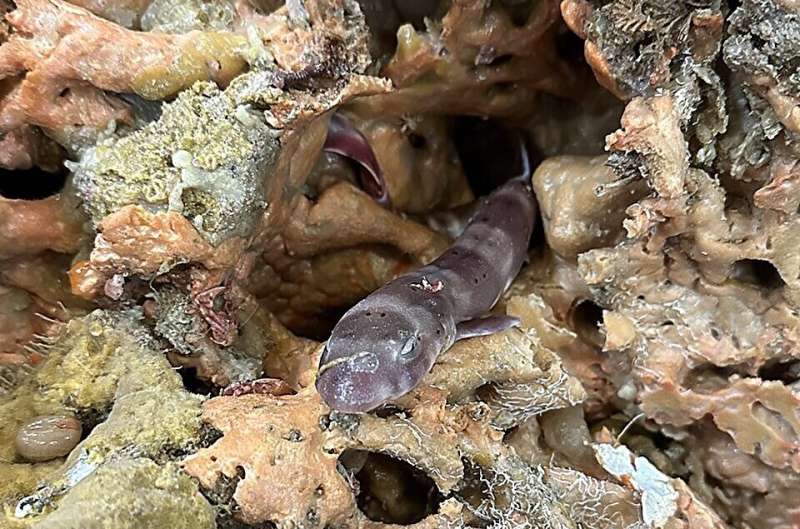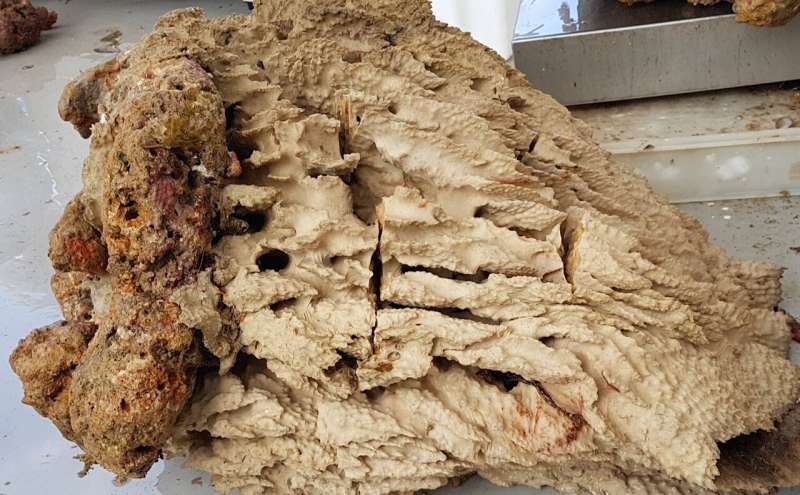This article has been reviewed according to Science X's editorial process and policies. Editors have highlighted the following attributes while ensuring the content's credibility:
fact-checked
peer-reviewed publication
trusted source
proofread
Scientists find banded sand catsharks hiding inside sea sponges

When scientists on board the research vessel (RV) Investigator pulled a large sponge from the ocean in 2017, they noticed a tail fin poking out. They expected to find an eel had wriggled into the sponge. Instead, they discovered 30 catsharks hiding inside.
It was the first known observation of a shark species living inside a sponge. The paper, "Sharks checking in to the sponge hotel: first internal use of sponges of the genus Agelas and family Irciniidae by banded sand catsharks Atelomycterus fasciatus," was published in the Journal of Fish Biology.
Sharks soak up the sponge life
This sponge and its catsharks were the first of five large sponges discovered to contain a total of 57 Banded sand catsharks. They were found during two voyages to survey marine biodiversity in marine parks off the coast of north-western Australia.
Helen O'Neill, a fish biologist at our Australian National Fish Collection, was on board the second voyage in late 2022. She said the sponges belonged to a few different species.
"They are large, some about a meter in diameter, with many folds, crevices and canals into which the sharks can swim. We found them at depths ranging from 32 to 106 meters," Helen said.
The sharks belonged to a single species known as the banded sand catsharks, Atelomycterus fasciatus. The individuals living in the sponges ranged from 12 to 39 centimeters in length, including both males and females of all ages.
Wriggling into an unusual microhabitat
Some species of bony fish use sponges as microhabitats. However, this behavior had never been seen before in sharks or other elasmobranchs, the group including sharks, rays, skates and sawfish. Some are known to lay their eggs on sponges, but not live inside them.
"A related species of catshark in the same genus is known to hide in rock crevices in captivity, so the behavior may not be limited to banded sand catsharks. It's possible that other sharks might use sponges too," Helen said.

Banded sand catsharks are nocturnal and demersal, meaning they live on the sea floor. They eat small fish and invertebrates and have snakelike bodies that are good for wriggling into sponges.
"We think they hide inside the sponges during the day to avoid predators. It's possible this also benefits the sponge, if the sharks eat some of the invertebrate species that prey on sponges," Helen said.
"On the other hand, housing a large number of sharks could be a problem for the sponges."
Diving into shark research
A small number of the banded sand catsharks found were kept as specimens for Australian fish collections, where they will be used for scientific research.
The rest were returned alive to the sea along with their sponge homes, after small pieces were retained for invertebrate collections.
"As well as observing this new behavior, we were able to extend the known range of banded sand catsharks by 250 kilometers to the south. They are endemic to north-western Australia," Helen said.
"Both voyages included surveys in marine parks, which are vital for conserving important marine habitats and the species that use them.
"The discovery of sharks living in sponges highlights the importance of intraspecific relationships between organisms. We still have so much learn about the behavior of sharks in the ocean."
More information: Helen L. O'Neill et al, Sharks checking in to the sponge hotel: first internal use of sponges of the genus Agelas and family Irciniidae by banded sand catsharks Atelomycterus fasciatus, Journal of Fish Biology (2023). DOI: 10.1111/jfb.15554
Journal information: Journal of Fish Biology
Provided by CSIRO





















